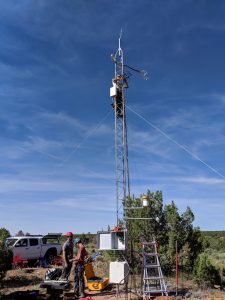Congratulations to the several AmeriFlux community members who have been awarded DOE funding for eddy-covariance flux research! In total, $11 million in funding was announced “to Study Critical Ecosystems and Improve Climate and Earth System Modeling.”
Notably, three of the PIs benefitted from the AmeriFlux support through the AmeriFlux Rapid-Response Flux System (RRS) program, the loaner program for the Year of Methane, and the instrument loaner program! The RRS is an eddy flux instrument package that the AmeriFlux Management Project (AMP) loans for research to take advantage of special research opportunities, for example that emerge quickly or have short measurement windows such as for wildfire or habitat restoration. Short term loaner instruments, including methane sensors, are available to the network, intended to minimize outages due to instrument failure or factory service/calibration.
Steve Kannenberg from the University of Utah (US-CdM) was awarded funding for the project ‘A general mechanistic framework for cross-scale understanding of hot spots and hot moments in carbon and water fluxes’. You can read more on the RRS deployment at US-CdM here.
Inke Forbrich from the Marine Biological Laboratory (US-PHM, US-PLM) was awarded funding for the project ‘From tides to seasons: How cyclic tidal drivers and plant physiology interact to affect carbon cycling at the terrestrial-estuarine boundary’. You can read more on the Year of Methane instrument loaner deployment at US-PHM here.
Patty Oikawa from California State University East Bay and Lisamarie Windham-Myers from the US Geological Survey (US-EDN, US-CGG) were awarded funding for the project ‘High-frequency Data Integration for Landscape Model Calibration of Carbon Fluxes Across Diverse Tidal Marshes ‘.
David Hoover from the USDA Agricultural Research Service (US-CX1, US-CX2) was awarded funding for the project ‘Droughts and deluges in semi-arid grassland ecosystems: Implications of co-occurring extremes for C cycling’.
Scott Saleska from the University of Arizona (BR-Sa1), was awarded funding for the project ‘Trees as conduits for connecting belowground microbial processes to aboveground CH4 emissions at the Terrestrial-Aquatic Interface’.
Congratulations to all!
A list of all recipients can be found at: https://science.osti.gov/-/media/ber/pdf/Awards/ESS_Awards_2021.pdf
Read more about AMP Technical support services: https://ameriflux.lbl.gov/tech/support-services/


No Comments
Be the first to start a conversation